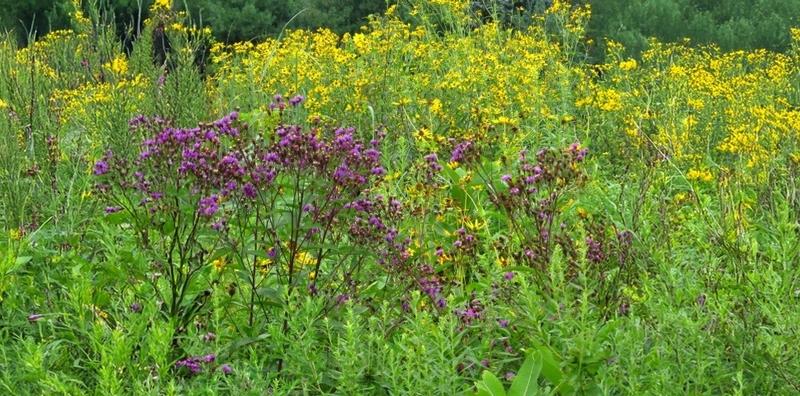No Dig Approach
Healthy soil is the foundation of every thriving landscape. Skip the chemicals and let your soil do the work. Discover how no dig gardening and native perennials create healthier, low-maintenance landscapes.
Cultivating an Organic Garden the No Dig Way
Organic gardening represents a systems-based approach to land management that prioritizes soil health, biodiversity, and long-term ecological function over short-term inputs. By shifting away from synthetic fertilizers and pesticides, practitioners can enhance soil structure, microbial activity, and nutrient cycling, key drivers of sustainable plant performance. No dig methods, combined with the strategic use of compost and organic mulches, minimize soil disturbance, conserve carbon, and reduce erosion. When paired with regionally adapted native perennials, this approach not only reduces maintenance inputs but also strengthens habitat value, pollinator support, and overall site resilience.
Why Go Organic and No Dig?
Enhancing soil biology: Eliminating synthetic fertilizers and pesticides fosters a diverse soil food web, which includes beneficial fungi, bacteria, and invertebrates critical for nutrient cycling and disease suppression. Chemical inputs often disrupt these relationships, while organic practices support natural processes that improve cation exchange capacity, water infiltration, and overall soil resilience.
Preserving soil structure: No dig gardening maintains the natural soil profile, avoiding compaction, erosion, and the destruction of fungal networks caused by tillage. Instead, fertility is built by layering organic amendments such as cardboard, compost, and leaf mulch, practices that create a biologically active, moisture-retentive soil horizon.
Optimizing with native perennials: Native plants are adapted to local hydrology, soil chemistry, and climate. When established in organic, undisturbed soil systems, they require fewer supplemental inputs, are less susceptible to stress, and provide critical ecosystem services such as pollinator habitat, stormwater management, and erosion control.
Establishing A System
- Foundation layering: Begin with sheet mulching—cardboard or newspaper to suppress existing vegetation—then alternate carbon-rich “brown” layers (e.g., straw, leaves) with nitrogen-rich “green” layers (e.g., grass clippings, food scraps), capped with compost. This creates a slow-release nutrient profile while encouraging earthworm activity.
- Precision planting: Instead of turning soil, pull back layers to install perennials directly into the organic mulch. Their roots quickly integrate into the biologically active substrate, which enhances early establishment and long-term vigor.
- Ongoing mulch management: Maintain a consistent 2–3" layer of shredded leaves, composted bark, or wood chips. This moderates soil temperature, conserves water, suppresses weeds, and continuously feeds microbial populations.
- System stability: Once established, native perennials thrive with minimal supplemental irrigation and no chemical intervention, making them ideal for sustainable landscapes, restoration projects, and low-maintenance designs.
Native Perennials
Milkweeds – Critical for monarch conservation and resilient in varied soil conditions.
- Asclepias incarnata – Prefers moist soils, excellent for rain gardens and wetland edges.
- Asclepias syriaca – Fragrant, robust, and suitable for meadows or naturalized plantings.
- Asclepias tuberosa – Drought-tolerant, thrives in sandy soils; bright orange flowers add ornamental impact.
- Asclepias verticillata – Fine-textured, adaptable, and deer-resistant for upland conditions.
Aster ‘Wood’s Blue’ – Compact form with heavy fall bloom; effective as a seasonal transition plant and low-maintenance alternative to mums.
Baptisia – Deep-rooted legumes that improve soil fertility through nitrogen fixation while adding architectural form.
- Baptisia alba var. macrophylla – Tall, structural perennial with long-lived clumps and white spring flowers.
- Baptisia sphaerocarpa – Yellow blooms, drought-tolerant, and highly durable in meadow or prairie-style plantings.
Carex rosea – A fine-textured woodland sedge that functions as a living mulch, stabilizing soil while reducing weed pressure.
Clematis virginiana – A vigorous native vine well-suited to trellises or naturalized woodland edges; thrives in organic, moisture-retentive soils.
Eupatorium maculatum – Tall, late-summer pollinator powerhouse for rain gardens, bioswales, and moist meadow landscapes.
Why They Excel
- Milkweeds – Establish well in undisturbed soils; support Lepidoptera and other pollinators; resilient under low-input management.
- Aster ‘Wood’s Blue’ – Reliable fall color; low maintenance; integrates seamlessly with organic mulch regimes.
- Baptisia – Nitrogen-fixing legumes that enhance soil fertility while providing seasonal ornamental interest.
- Carex rosea – Effective shade groundcover; builds organic matter over time.
- Clematis virginiana – Woody perennial that benefits from consistent mulch and soil moisture without disturbance.
- Eupatorium maculatum – Performs well in organically managed stormwater systems and pollinator habitats.
For landscapers and restoration professionals, integrating organic, no dig practices with carefully selected native perennials provides measurable ecological and maintenance benefits. By prioritizing soil biology and minimizing disturbance, these systems reduce long-term input costs while enhancing biodiversity and resilience. Native perennials such as Asclepias, Aster, Baptisia, Carex, Clematis, and Eupatorium not only perform reliably in organically managed settings but also contribute to the ecological integrity and aesthetic value of the designed landscape.


